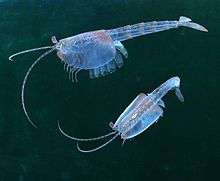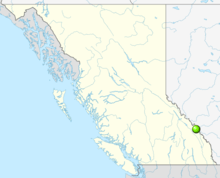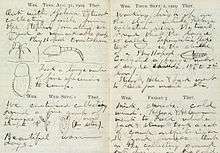Waptia
Waptia fieldensis is an extinct species of arthropod from the Middle Cambrian Burgess Shale Lagerstätte of Canada. It grew to a length of about 8 cm (3 in) and resembled modern shrimp in both morphology and habit. It had a large bivalved carapace and a segmented body terminating into a pair of tail flaps. It was an active swimmer, feeding on organic particles it gathered from the seafloor substrate. It is also one of the oldest animals with direct evidence of brood care.
| Waptia | |
|---|---|
 | |
| Artist's reconstruction of Waptia fieldensis | |
| Scientific classification | |
| Kingdom: | Animalia |
| Phylum: | Arthropoda |
| Clade: | Pancrustacea |
| Order: | †Hymenocarina |
| Genus: | †Waptia Walcott, 1912 |
| Species: | †W. fieldensis |
| Binomial name | |
| †Waptia fieldensis Walcott, 1912 | |
 | |
| Location of the Burgess Shale Formation in British Columbia | |
Based on the number of individuals, Waptia fieldensis is the third most abundant arthropod from the Burgess Shale Formation, with thousands of specimens collected. It was among the first fossils found by the American paleontologist Charles D. Walcott in 1909. He described it in 1912 and named it after two mountains near the discovery site – Wapta Mountain and Mount Field.
Waptia fieldensis is the only species classified under the genus Waptia. Although it bears a remarkable resemblance to modern crustaceans, its taxonomic affinities remain unclear. It is currently classified as a stem group crustacean and tentatively included in the clade Crustaceomorpha with its close relatives in the clade Hymenocarina.

Description
Waptia fieldensis had a maximum body length of 8 centimetres (3.1 in).[1] The exoskeleton was very thin and easily distorted from fossilisation. It possessed a large bivalved carapace that was narrow at the front with wide posterior margins that covered the cephalon and most of the thorax. The cephalon had five short somites (body segments) with three to five pairs of small and poorly preserved feeding appendages.[2][3]
A single pair of long and slender antennae is present, the segments of which are relatively few and elongated.[4][5] They were most probably used as sensory organs, with most segments possessing small setae (bristles).[6] A pair of short lobed structures (possible antennules) are also present, their position corresponding to the location of the second pair of antennae in modern-day crustaceans. In between them is a small triangular rostral plate with a narrow and sharp central ridge.[2][3]
The well-developed compound eyes were stalked.[4][7] The striking morphological similarities of the eyes of Waptia fieldensis to that of extant mysid shrimp make it very likely that they were capable of producing true visual images or were at least sensitive to motion.[8][9][10] A median eye may have also been present.[10] Nervous tissue, including a putative brain, has been identified.[11]


The thorax is divided into two groups of somites. The anterior group is composed of four somites, each with well-developed walking limbs with lengths that extend past the margins of the carapace. Their morphological details are not well preserved but their distal segments appear to possess a multitude of small spines. It is unknown if these limbs are biramous, but they are assumed to be the endopodites, the inner branches (ramus) of the leg, with the exopodites, or outer branches, absent or not preserved.[2][5]
The posterior thoracic group is made up of six somites, each possessing a pair of long multi-jointed appendages. The segments of these appendages are longer near the body and taper towards the flexible distal segments, extending past the carapace.[2] They bear a fringe of long, slender filaments, all of which are directed towards the middle of the body, a characteristic shared by extant crustaceans.[5] Though usually squashed into blade-like shapes from the fossilisation process, the filaments were slender cylindrical tubes when the animal was alive. The filaments at the tipmost segment are often bunched together. These appendages are believed to be the exopodites and may have functioned as gills and as swimming limbs. They are possibly biramous, with some specimens showing traces of what may be small endopodites at their bases.[6][12][13]
The abdomen is composed of five somites, all of which lack appendages except the last. The back-facing margins of these somites bear small spines and four or more larger spines.[2] The last abdominal somite forks into a pair of flattened spatulate appendages (the uropods) that function as a tail fan (caudal rami).[4][6][14] In addition to stabilising the body while swimming, a quick flick of the tail fan can rapidly propel the animal backwards, which may have functioned as a means of escaping predators like in modern shrimp.[6][15] Traces of four fused segments are evident in the three faint lines dividing each lobe of the tail fan.[2] A long telson is present at the end of the body.[1] Traces of a rounded stomach, small digestive glands, and an intestine that terminates into a tiny anal opening on the telson can also be observed in some specimens.[2]
Discovery

Waptia fieldensis was one of the first fossils discovered by Charles D. Walcott from the Burgess Shale in August 1909. A rough sketch of Waptia is present in his diary for August 31, 1909, alongside sketches of Marrella and Naraoia.[13][17] A formal description for the species was published by Walcott in 1912. The species was named after the two mountains connected by the Fossil Ridge containing the Burgess Shale locality, Wapta Mountain and Mount Field of Yoho National Park, British Columbia, Canada.[1][18] The name of Wapta Mountain itself comes from the First Nation Nakoda word wapta, meaning "running water"; while Mount Field was named after the American telecommunications pioneer Cyrus West Field.[1]
Taphonomy
Specimens of Waptia fieldensis were recovered from the Burgess Shale Lagerstätte of Canada, which dates from the Middle Cambrian period (510 to 505 million years ago).[19] The locality was once about 200 m (660 ft) underwater; it was located at the bottom of a warm and shallow tropical sea adjacent to a submarine limestone cliff (now the Cathedral Limestone Formation). Undersea landslides caused by the collapse of parts of the limestone cliff would periodically bury the organisms in the area (as well as organisms carried by the landslides) in fine-grained mud that later became shale.[20]
Based on the number of individuals, Waptia fieldensis constitutes about 2.55% of the total number of organisms recovered from the Burgess Shale, and 0.86% of the Greater Phyllopod bed.[21] This makes them the third most abundant arthropods of the Burgess Shale (after Marrella and Canadaspis).[17][19] The National Museum of Natural History alone houses more than a thousand specimens of the species from the Burgess Shale.[6] Waptia fieldensis are often found disarticulated, with parts remaining in close proximity to each other.[21]
Several possible specimens of W. fieldensis were also recovered from the Middle Cambrian Spence Shale member of the Langston Formation in Utah in 2008.[1][22][23]
Taxonomy
Waptia fieldensis is the only species accepted under the genus Waptia. It is classified under the family Waptiidae (established by Walcott in 1912), the order Waptiida (established by Leif Størmer in 1944), and (tentatively) the clade Crustaceomorpha.[6][24] Early restorations of Waptia fieldensis by Charles R. Knight in 1940 erroneously depicted it as a primitive shrimp, but modern paleontologists now consider it among the Burgess Shale arthropods that are of unknown and uncertain taxonomic placement.[17]


Some authors have suggested that it may be allied to crustaceans, but like many Cambrian crustaceomorphs, the mouthparts were not preserved, making it impossible to reliably classify them within the crustacean crown group. Others propose that it may be only distantly related to crustaceans, being at least a member of a stem group of crustaceans, or even of all arthropods.[1] Despite being one of the first species recovered and being the third most abundant fossils of the Burgess Shale, there is still no in-depth work on the morphology of Waptia fieldensis.[6]
In 1975, an apparently very similar species was described from the Lower Cambrian (515 to 520 million years ago) Maotianshan Shale Lagerstätte of Chengjiang, China. It was originally placed within the "ostracod"-like genus Mononotella, as Mononotella ovata. In 1991, Xian-Guang Hou and Jan Bergström reclassified it under the new genus Chuandianella when additional discoveries of more complete specimens made its resemblance to W. fieldensis more apparent. Like W. fieldensis, Chuandianella ovata had a bivalved carapace with a median ridge, a pair of caudal rami, a single pair of antennae, and stalked eyes. In 2004, Jun-Yuan Chen tentatively transferred it to the genus Waptia. However, C. ovata had eight abdominal somites in contrast to five in W. fieldensis. Its limbs were biramous and were undifferentiated, unlike those of W. fieldensis.[6] Other authors deemed these differences to be enough to separate it from Waptia to its own genus.[1][25]
In 2002, a second similar species, Pauloterminus spinodorsalis, was recovered from the Lower Cambrian Sirius Passet Lagerstätte of the Buen Formation of northern Greenland. It was also identified as a possible waptiid. Like C. ovata it had biramous undifferentiated appendages, but it also had only five abdominal somites like W. fieldensis. However, the poor preservation of the P. spinodorsalis specimens, particularly of the appendages on the head, make it difficult to ascertain its taxonomic placement. This difficulty is further compounded by evidence that the fossils of P. spinodorsalis may in fact be moults (exuviae), and not of the actual animal.[6]
Ecology
In addition to their striking, superficial similarity to contemporary shrimp, Waptia fieldensis were also very shrimp-like in their habits.[5][26] They were bottom-dwelling (nektobenthic) deposit feeders.[27] The lack of strong feeding appendages indicates that they were more likely to feed by sifting through the sea bottom for edible organic particles.[13] Their tails and the feather-like filaments on their posterior thoracic somites also imply that they were active swimmers.[2]
In 2015, egg clutches were identified in six specimens from the Burgess Shale. The clutch sizes were small, only containing up to 24 eggs, but each egg was relatively large, with an average diameter of 2 mm (0.079 in). They were tucked inside the carapace, attached along the inner surface. Along with Kunmingella douvillei from the Chengjiang biota (around 7 million years older than the Burgess Shale), which also had fossilized eggs preserved inside the carapace, they constitute the oldest direct evidence of brood care and of K-selection among animals. It indicates that they probably lived in an environment which required them to take special measures to ensure the survival of their young.[28][29][30]
See also
References
- "Waptia fieldensis". Royal Ontario Museum. 2011. Retrieved January 14, 2012.
- Charles D. Walcott (1931). "Addenda to descriptions of Burgess shale fossils". Smithsonian Miscellaneous Collections. 85 (3): 1–46. Bibcode:1932JG.....40...95.. doi:10.1086/623925.
- Rod S. Taylor & Desmond H. Collins (2002), "Waptia fieldensis, a possible crustacean from the Middle Cambrian Burgess Shale of British Columbia, Canada (The Palaeontological Association 46th Annual Meeting, 15th–18th December 2002)" (PDF), The Palaeontology Newsletter (51), pp. 74–147
- Percy E. Raymond (1920). "The appendages, anatomy, and relationships of trilobites". Memoirs of the Connecticut Academy of Arts and Sciences. 7: 1–169. doi:10.5962/bhl.title.28256.
- Jan Bergström & Xian-Guang Hou (2005). "Early Palaeozoic non-lamellipedian arthropods". In Stefan Koenemann & Ronald A. Jenner (eds.). Crustacea and Arthropod Relationships. Taylor & Francis Group. pp. 73–93. ISBN 978-0-8493-3498-6.
- Rod S. Taylor (2002). "A new bivalved arthropod from the Early Cambrian Sirius Passet fauna, North Greenland". Palaeontology. 45 (Part 1): 97–123. doi:10.1111/1475-4983.00229.
- Andrew Richard Parker (2005). "A geological history of reflecting optics". Journal of the Royal Society Interface. 2 (2): 1–17. doi:10.1098/rsif.2004.0026. PMC 1578258. PMID 16849159.
- Andrew Richard Parker (1998). "Colour in Burgess Shale animals and the effect of light on evolution in the Cambrian". Proceedings of the Royal Society B. 265 (1400): 967–972. doi:10.1098/rspb.1998.0385. JSTOR 51026. PMC 1689164.
- Nicholas Strausfield; John Douglass; Holly Campbell & Charles Higgins (2006). "Parallel processing in the optic lobes of flies and the occurrence of motion computing circuits". In Eric Warrant & Dan-Eric Nilsson (eds.). Invertebrate Vision. Cambridge University Press. p. 359. ISBN 978-0-521-83088-1.
- Ivan R. Schwab (2011). Evolution's Witness: How Eyes Evolved. Oxford University Press. pp. 44–45. ISBN 978-0-19-536974-8.
- Nicholas J. Strausfeld (2011). "Some observations on the sensory organization of the crustaceamorph Waptia fieldensis Walcott". Palaeontographica Canadiana (31): 157–169.
- Charles D. Walcott (1931). "Addenda to descriptions of Burgess shale fossils" (PDF). Smithsonian Miscellaneous Collections. 85 (3): 1–46. Bibcode:1932JG.....40...95.. doi:10.1086/623925.
- Derek E. G. Briggs; Douglas H. Erwin & Frederick J. Collier (1994). The Fossils of the Burgess Shale. Smithsonian Institution Press. pp. 157–158. ISBN 1-56098-364-7.
- Kenneth E. Caster & H. K. Brooks (1955–1956). "New fossils from the Canadian-Chazyan (Ordovician) Hiatus in Tennessee". Bulletins of American Paleontology. 36 (157): 157–199.
- Simon Conway Morris & Harry Blackmore Whittington (1985). Fossils of the Burgess Shale: A National Treasure in Yoho National Park, British Columbia. Geological Survey of Canada Miscellaneous Report 43. Geological Survey of Canada. p. 4. ISBN 978-0-660-11901-4.
- Smithsonian Institution Archives, Accession 10-166, Walcott, Charles D, (Charles Doolittle), 1850-1927, Charles D. Walcott Collection
- Stephen Jay Gould (1989). Wonderful Life: The Burgess Shale and the Nature of History. W. W. Norton & Company. ISBN 9780393027051.
- Charles D. Walcott (1912). "Cambrian geology and paleontology II: Middle Cambrian Branchiopoda, Malacostraca, Trilobita, and Merostomata". Smithsonian Miscellaneous Collections. 57 (6): 453–456.
- Simon Conway Morris (1986). "The community structure of the Middle Cambrian Phyllopod Bed (Burgess Shale)". Palaeontology. 29 (Part 3): 423–467.
- James W. Hagadorn (2002). "Burgess Shale: Cambrian Explosion in Full Bloom". In David J. Bottjer; et al. (eds.). Exceptional Fossil Preservation: A Unique View on the Evolution of Marine Life. Columbia University Press. pp. 61–89. ISBN 978-0-231-10254-4.
- Jean-Bernard Caron & Donald A. Jackson (2006). "Taphonomy of the Greater Phyllopod Bed community, Burgess Shale". PALAIOS. 21 (5): 451–465. Bibcode:2006Palai..21..451C. doi:10.2110/palo.2003.P05-070R.
- "Waptia cf. fieldensis Walcott, 1912". Division of Invertebrate Paleontology, University of Kansas. October 4, 2007. Retrieved January 14, 2012.
- Derek E. G. Briggs; Bruce S. Lieberman; Jonathan R. Hendricks; Susan L. Halgedahl & Richard D. Jarrard (2008). "Middle Cambrian Arthropods from Utah". Journal of Paleontology. 82 (2): 238–254. doi:10.1666/06-086.1.
- Mikko Haaramo (October 4, 2007). "Crustaceomorpha – crustaceans and related arthropods". Mikko's Phylogeny Archive. Retrieved January 14, 2012.
- Hu-Qin Liu & De-Gan Shu (2004). "New information on Chuandianella from the Lower Cambrian Chengjiang Fauna, Yunnan, China" [澄江化石库中川滇虫属化石的新信息]. Journal of Northwest University (Natural Science Edition) (in Chinese). 34 (4): 453–456.
- Richard K. Bambach; Andrew M. Bush & Douglas H. Erwin (2007). "Supplementary data for: Autecology and the filling of ecospace: key metazoan radiations" (PDF). Palaeontology. 50 (Supplement – Part 1): 1–22. doi:10.1111/j.1475-4983.2006.00611.x.
- Roy E. Plotnick; Stephen Q. Dornbos & Jun-Yuan Chen (2010). "Information landscapes and sensory ecology of the Cambrian Radiation". Paleobiology. 36 (2): 303–317. doi:10.1666/08062.1.
- Jean-Bernard Caron & Jean Vannier (2016). "Waptia and the diversification of brood care in early arthropods". Current Biology. 26 (1): 69–74. doi:10.1016/j.cub.2015.11.006. PMID 26711492.
- Yanhong Duana; Jian Hana; Dongjing Fua; Xingliang Zhanga; Xiaoguang Yanga; Tsuyoshi Komiyac & Degan Shua (2014). "Reproductive strategy of the bradoriid arthropod Kunmingella douvillei from the Lower Cambrian Chengjiang Lagerstätte, South China". Gondwana Research. 25 (3): 983–990. Bibcode:2014GondR..25..983D. doi:10.1016/j.gr.2013.03.011.
- Emily Chung (18 December 2015). "Burgess Shale fossil Waptia may be oldest mom ever found caring for eggs". CBC News. Retrieved 24 May 2016.
External links
| Wikimedia Commons has media related to Waptia. |
- "Waptia fieldensis". Burgess Shale Fossil Gallery. Virtual Museum of Canada. 2011.
- "Waptia fieldensis". Smithsonian National Museum of Natural History. 2012.